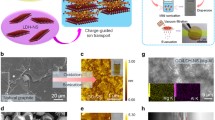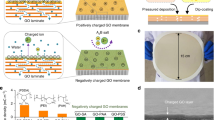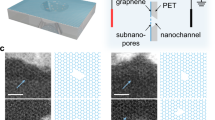Abstract
Recent advances in synthetic membrane technologies for purification and desalination of water and biotechnology are actively pursued. However, limited performance of current solid-state membranes calls for novel formulations offering both high permeability (ion and water flux) and ion differentiation (selectivity), considered as antagonist features. We report the development of hybrid nanoporous membranes comprising polycarbonate track-etched pores in which biological ion channels Gramicidin-A, alpha-hemolysin (α-HL), and outer-membrane protein F (OmpF) aquaporins are confined, and graphene oxide-conjugated cobalt ion-selective binding peptide motifs (Copep) are adsorbed, referred as bioinspired and biomimetic approaches, respectively. These solid-state nanoporous membranes offer scalability, mechanical robustness, selectivity, controlled pore dimension, and shape, for sustainable water production. The ion permeability, ion diffusion coefficient, and selective ion recognition are evaluated via nanofiltration, cell diffusion kinetics, and UV–Visible absorption spectroscopy. The experimental findings elucidate key performance parameters (ion confinement, rich surface chemistry, peptide-induced channel for selective ion transport) and provide new avenues for artificial ion channels by synergistic combination of eco-friendly material design such as GO enabled bio-molecular recognition chemistry.
Graphical abstract









Similar content being viewed by others
Data availability
The data that support the findings of this study are available within the article.
References
C.A. Grady, S.-C. Weng, E.R. Blatchley III., Potable water (Springer, Cham, 2014), pp.37–59
R. Jain, Providing safe drinking water: a challenge for humanity. Clean Technol. Environ. Policy 14, 1–9 (2012)
M.A. Shannon, P.W. Bohn, M. Elimelech, J.G. Georgiadis, B.J. Marinas, A.M. Mayes, Science and technology for water purification in the coming decades. Nature 452, 301–310 (2008)
D.L. Shaffer, N.Y. Yip, J. Gilron, M. Elimelech, Seawater desalination for agriculture by integrated forward and reverse osmosis: Improved product water quality for potentially less energy. J. Memb. Sci. 415, 1–8 (2012)
L. Huang, M. Zhang, C. Li, G. Shi, Graphene-based membranes for molecular separation. J. Phys. Chem. Lett. 6, 2806–2815 (2015)
M. Hu, B. Mi, Enabling graphene oxide nanosheets as water separation membranes. Environ. Sci Technol. 47, 3715–3723 (2013)
M. Elimelech, The global challenge for adequate and safe water. J. Water Supply. Res. Technol. 55, 3–10 (2006)
F. Perreault, A.F. de Faria, M. Elimelech, Environmental applications of graphene-based nanomaterials. Chem. Soc. Rev. 44, 5861–5896 (2015)
D. Chohen-Tanugi, J.C. Grossman, Mechanical strength of nanoporous graphene as a desalination membrane. Nano Lett. 14, 6171–6178 (2014)
L.F. Greenlee, D.F. Lawler, B.D. Freeman, B. Marrot, P. Moulin, Reverse osmosis desalination: water sources, technology, and today’s challenges. Water Res. 43, 2317–2348 (2009)
T. Basile, A. Petrella, M. Petrella, G. Boghetich, V. Petruzzelli, S. Colasuonno, D. Petruzzelli, Review of endocrine-disrupting-compound removal technologies in water and wastewater treatment plants: an EU perspective. Ind. Eng. Chem. Res. 50, 8389–8401 (2011)
M. Buonomenna, Nano-enhanced reverse osmosis membranes. Desalination 314, 73–80 (2013)
S. Gupta, A. Henson, B. Evans, Novel formulations for scalable multilayer nanoporous graphene-based membranes for use in efficient water detoxification revisited. Desalin. Water Treat. 169(59–71), 36 (2019)
S. Garaj, S. Liu, J.A. Golovchenko, D. Branton, Molecule-hugging graphene nanopores. Proc. Nat. Acad. Sci. 110, 12192–12196 (2013)
M. Elimelech, The global challenge for adequate and safe water. J. Water Supply: Res. Technol. 55, 3–10 (2006)
M.M. Pendergast, E.M.V. Hoek, A review of water treatment membrane nanotechnologies. Energy Environ. Sci. 4, 1946–1971 (2011)
S. Gupta, B. Evans, Interplay of graphene oxide and interfacial polymerized polyamide-crosslinked thin-film composite membranes for enhanced performance during reverse osmosis. Desalin. Water Treat. 218, 177–192 (2021)
G.M. Geise, H.S. Lee, D.J. Miller, B.D. Freeman, J.E. Mcgrath, D.R. Paul, Water purification by membranes: the role of polymer science. J. Polym. Sci. Part B: Polym. Phys. 48, 1685–1718 (2010)
C.R. Martin, M. Nishizawa, K. Jirage, M.S. Kang, S.B. Lee, Controlling ion–transport selectivity in gold nanotubule membranes. Adv. Mater. 13, 1351–1362 (2001)
M. Ali, B. Yameen, R. Neumann, W. Ensinger, W. Knoll, O.J. Azzaroni, Biosensing and supramolecular bioconjugation in single conical polymer nanochannels. facile incorporation of biorecognition elements into nanoconfined geometries. Am Chem Soc 130, 16351–16357 (2008)
I. Vlassiouk, T.R. Kozel, Z.S. Siwy, Biosensing with nanofluidic diodes. J. Am. Chem. Soc. 131, 8211–8220 (2009)
S. Majd, E.C. Yusko, Y.N. Billeh, M.X. Macrae, J. Yang, M. Mayer, Applications of biological pores in nanomedicine, sensing, and nanoelectronics. Curr. Opin. Biotechnol. 21, 439–476 (2010)
B.E. Logan, M. Elimelech, Membrane-based processes for sustainable power generation using water. Nature 488, 313–319 (2012)
J. Zhao, X. Zhao, Z. Jiang, Z. Li, X. Fan, J. Zhu, H. Wu, Y. Su, D. Yang, F. Pan, J. Shi, Biomimetic and bioinspired membranes: preparation and application. Prog. In Polym. Sci. 39, 1668–1720 (2014)
S.P. Tsunoda, B. Wiesner, D. Lorenz, W. Rosenthal, P. Pohl, Aquaporin-1, nothing but a water channel. J. Biol. Chem. 279, 11364–11367 (2004)
B. Hille, In ion channels of excitable membranes, 3rd edn. (Sinauer Associates, Sunderland, MA, 2001)
S. Gupta, J. Dura, A. Freites, D. Tobias, J.K. Blasie, Structural characterization of the voltage sensor domain and voltage-gated K+-channel proteins vectorially oriented within a single bilayer at the solid/vapor and solid/liquid interfaces via neutron interferometry. Langmuir 28, 10504–10520 (2012)
A. Tronin, C.-H. Chen, S. Gupta, D. Worcester, V. Lauter, J. Strzalka, I. Kuzmenko, J.K. Blasie, Structural changes in single phospholipid membranes in response to an applied transmembrane electric potential revealed by time-resolved neutron/X-ray interferometry. Chem. Phys. 422, 283–289 (2013)
S. Gupta, J. Liu, J. Strzalka, J.K. Blasie, Profile structure of the voltage sensor domain and KvAP channel within single membranes via X-ray interferometry. Phys Rev E 84, 031911–032115 (2011)
K. Ariga, Silica-supported biomimetic membranes. Chem. Rec. 4, 59–59 (2004)
W. Meier, C. Nardin, M. Winterhalter, Reconstitution of channel proteins in (Polymerized) ABA triblock copolymer membranes. Angew. Chem. Int. Ed. 39, 4599 (2000)
M. Kumar, M. Grzelakowski, J. Zilles, M. Clark, W. Meier, Highly permeable polymeric membranes based on the incorporation of the functional water channel protein aquaporin Z. Proc. Natl. Acad. Sci. U.S.A. 104, 20719–20724 (2007)
A. Gonzalez-Perez, K.B. Stibius, T. Vissing, C.H. Nielsen, O.G. Mouritsen, Biomimetic triblock copolymer membrane arrays: a stable template for functional membrane proteins. Langmuir 25, 10447–10450 (2009)
C. Dekker, Solid-state nanopores. Nat. Nanotechnol. 2, 209–215 (2007)
M. Ali, S. Nasir, Q.H. Nguyen, J.K. Sahoo, M.N. Tahir, W. Tremel, W. Ensinger, Metal ion affinity-based biomolecular recognition and conjugation inside synthetic polymer nanopores modified with iron–terpyridine complexes. J. Am. Chem. Soc. 133, 17307–17314 (2011)
S.P. Surwade, S.N. Smirnov, I.V. Vlassiouk, R.R. Unocic, G.M. Veith, S. Dai, S.M. Mahurin, Water desalination using nanoporous single-layer graphene. Nat. Nanotechnol. 10, 459–464 (2015)
M. Lozada-Hidalgo, S. Hu, O. Marshall, A. Mishchenko, A.N. Grigorenko, R.A.W. Dryfe, B. Radha, I.V. Grigorieva, A.K. Geim, Sieving hydrogen isotopes through two-dimensional crystals. Science 351, 68–70 (2016)
R.K. Joshi, P. Carbone, F.C. Wang, V.G. Kravets, Y. Su, I.V. Grigorieva, H.A. Wu, A.K. Geim, R.R. Nair, Precise and ultrafast molecular sieving through graphene oxide membranes. Science 343, 752–754 (2014)
D. Konatham, J. Yu, T.A. Ho, A. Striolo, Simulation insights for graphene-based desalination membranes. Langmuir 29(11884–11897), 38 (2013)
H.B. Wang, Q. Zhang, X. Chu, T.T. Chen, J. Ge, R.Q. Yu, Graphene oxide-peptide conjugate as an intracellular protease sensor for caspase-3 activation imaging in live cells. Angew. Chem. Int. Ed. 50, 7065–7069 (2011)
L.M. Zhang, J.G. Xia, Q.H. Zhao, L.W. Liu, Z.J. Zhang, Functional graphene oxide as a nanocarrier for controlled loading and targeted delivery of mixed anticancer drugs. Small 6, 537–544 (2010)
P. Sun, M. Zhu, K. Wang, M. Zhong, J. Wei, D. Wu, Z. Xu, H. Zhu, Selective ion penetration of graphene oxide membranes. ACS Nano 7, 428–436 (2012)
A. Calvo, B. Yameen, F.J. Williams, G. Soler-Illia, O. Azzaroni, Mesoporous films and polymer brushes helping each other to modulate ionic transport in nanoconfined environments. An interesting example of synergism in functional hybrid assemblies. J. Am. Chem. Soc. 131, 10866–10868 (2009)
H.W. Kim, H.W. Yoon, S.M. Yoon, B.M. Yoo, B.K. Ahn, Y.H. Cho, H.J. Shin, H. Yang, U. Paik, S. Kwon, J.Y. Choi, H.B. Park, Selective gas transport through few-layered graphene and graphene oxide membranes. Science 342, 91–95 (2013)
A. Cazacu, Y.M. Legrand, A. Pasc, G. Nasr, A. Van der Lee, E. Mahon, M. Barboiu, Dynamic hybrid materials for constitutional self-instructed membranes. Proc. Natl. Acad. Sci. U.S.A. 106, 8117–8122 (2009)
P. Kohli, C.C. Harrell, Z.H. Cao, R. Gasparac, W.H. Tan, C.R. Martin, DNA−nanotube artificial ion channels. Science 305, 984–986 (2004)
S. Kim, J. Nham, Y.S. Jeong, C.S. Lee, S.H. Ha, H.B. Park, Y.J. Lee, Biomimetic selective ion transport through graphene oxide membranes functionalized with ion recognizing peptides. Chem. Mater. 27, 1255–1261 (2015)
S. Balme, J.-M. Janot, L. Berardo, F. Henn, D. Bonherry, S. Kraszewski, F. Picaud, C. Ramseyer, New bioinspired membrane made of a biological ion channel confined into the cylindrical nanopore of a solid-state polymer. Nano Lett. 11, 712–716 (2011)
W. Guo, L.X. Cao, J.C. Xia, F.Q. Nie, W. Ma, J.M. Xue, Y.L. Song, D.B. Zhu, Y.G. Wang, L. Jiang, Energy harvesting with single-ion-selective nanopores: a concentration-gradient-driven nanofluidic power source. Adv. Funct. Mater. 20, 1339–1344 (2010)
K.M. Williams, E.C. Bigley 3rd., R.B. Raybourne, Identification of murine B-cell and T-cell epitopes of Escherichia coli outer membrane protein F with synthetic polypeptides. Infect Immun. 68(2535–2545), 39 (2000)
M. Sarikaya, C. Tamerler, A.K.Y. Jen, K. Schulten, F. Baneyx, Molecular biomimetics: nanotechnology through biology. Nat. Mater. 2, 577–585 (2003)
U. Hersel, C. Dahmen, H. Kessler, RGD modified polymers: biomaterials for stimulated cell adhesion and beyond. Biomaterials 24, 4385–4415 (2003)
C.L. Chen, N.L. Rosi, Peptide-based methods for the preparation of nanostructured inorganic materials. Angew. Chem. Int. Ed. 49, 1924–1942 (2010)
S.R. Whaley, D.S. English, E.L. Hu, P.F. Barbara, A.M. Belcher, Selection of peptides with semiconductor binding specificity for directed nanocrystal assembly. Nature 405, 665–668 (2000)
D.Y. Oh, X.N. Dang, H.J. Yi, M.A. Allen, K. Xu, Y.J. Lee, A.M. Belcher, Graphene sheets stabilized on genetically engineered M13 viral templates as conducting frameworks for hybrid energy-storage materials. Small 8, 1006–1011 (2012)
B. He, G. Chai, Y. Duan, Z. Yan, L. Qiu, H. Zhang, Z. Liu, Q. He, K. Han, B. Ru, F.-B. Guo, H. Ding, H. Lin, X. Wang, N. Rao, P. Zhou, J. Huang, BDB: biopanning data bank. Nucleic Acids Res. 44, D1127–D1132 (2016)
S.K. Lee, D.S. Yun, A.M. Belcher, Cobalt ion mediated self-assembly of genetically engineered bacteriophage for biomimetic Co−Pt hybrid material. Biomacromol 7, 14–17 (2006)
S. Balme, J.M. Janot, P. Dejardin, E.N. Vasina, P. Seta, Potentialities of confocal fluorescence for investigating protein adsorption on mica and in ultrafiltration membranes. J. Memb. Sci. 284, 198–204 (2006)
A. Plecis, R.B. Schoch, P. Renaud, Ionic transport phenomena in nanofluidics: experimental and theoretical study of the exclusion-enrichment effect on a chip. Nano Lett. 5, 1147–1155 (2005)
M. Barboiu, Y. Le Duc, A. Gilles, P.A. Cazade, M. Michau, Y.M. Legrand, A. van der Lee, B. Coasne, P. Parvizi, J. Post, T. Fyles, An artificial primitive mimic of the gramicidin-A channel. Nat. Commun. 5, 4142–4146 (2014)
X.S. Sun, C.L. Xiao, R.G. Ge, X.F. Yin, H. Li, N. Li, X.Y. Yang, Y. Zhu, X. He, Q.Y. He, Putative copper- and zinc-binding motifs in Streptococcus pneumoniae identified by immobilized metal affinity chromatography and mass spectrometry. Proteomics 11(3288–3298), 40 (2011)
B. Corry, Mechanisms of selective ion transport and salt rejection in carbon nanostructures. MRS Bull. 42, 306–310 (2017)
P.W. Atkins, Physical chemistry, 5th edn. (Oxford University Press, Oxford, 1992)
S.P. Pinho, E.A. Macedo, Solubility of NaCl, NaBr, and KCl in water, methanol, ethanol, and their mixed solvents. J. Chem. Eng. Data 50, 29–32 (2005)
Acknowledgments
The author (S.G.) gratefully acknowledges the financial support by NSF-MRI (Grant# 1429563), KY NSF EPSCoR RSP (Subaward# 3200000271-17-212), and co-author (T.R.) for researcher scholarship, and internal RCAP WKU Foundation award. The undergraduate student co-authors (T.R., B.E.) are grateful to John Andersland (Biology) and Naomi Rowland (Biology) for scanning electron microscopy and confocal fluorescence spectroscopy training, respectively.
Funding
National Science Foundation-MRI 1429563, Sanju Gupta
Author information
Authors and Affiliations
Contributions
SG contributed to conceptualization, investigation, data curation, analysis, supervision, funding acquisition, resources, writing—original draft, reviewing, and editing. TR contributed to data curation and analysis. BE contributed to data curation and analysis.
Corresponding author
Ethics declarations
Conflict of interest
The authors declare that they have no known competing financial interests that could have appeared to influence the work reported in this paper.
Additional information
Publisher's Note
Springer Nature remains neutral with regard to jurisdictional claims in published maps and institutional affiliations.
Rights and permissions
Springer Nature or its licensor (e.g. a society or other partner) holds exclusive rights to this article under a publishing agreement with the author(s) or other rightsholder(s); author self-archiving of the accepted manuscript version of this article is solely governed by the terms of such publishing agreement and applicable law.
About this article
Cite this article
Gupta, S., Robinson, T. & Evans, B. Bioinspired and biomimetic membranes using ion channel proteins and designer peptides conjugated with graphene oxide for selective ion transport. Journal of Materials Research 38, 3519–3535 (2023). https://doi.org/10.1557/s43578-023-01076-9
Received:
Accepted:
Published:
Issue Date:
DOI: https://doi.org/10.1557/s43578-023-01076-9




